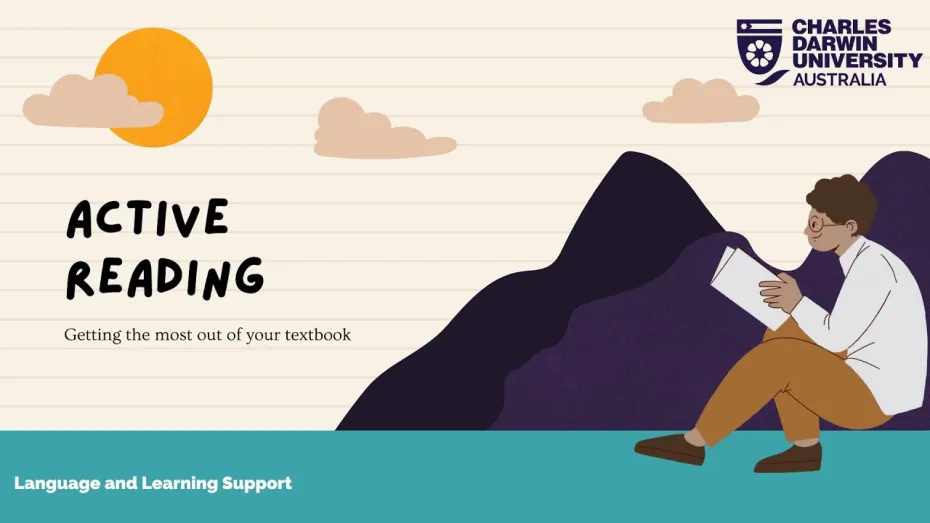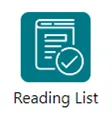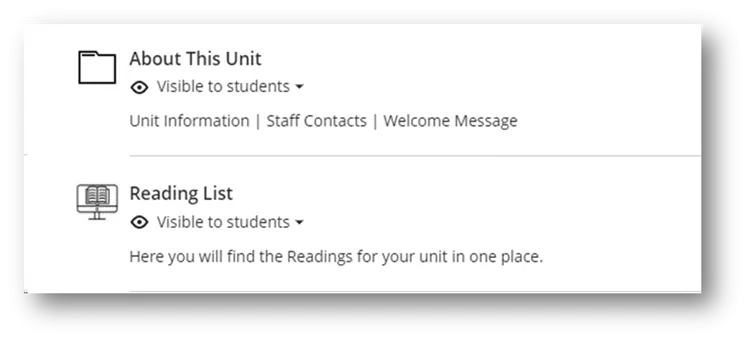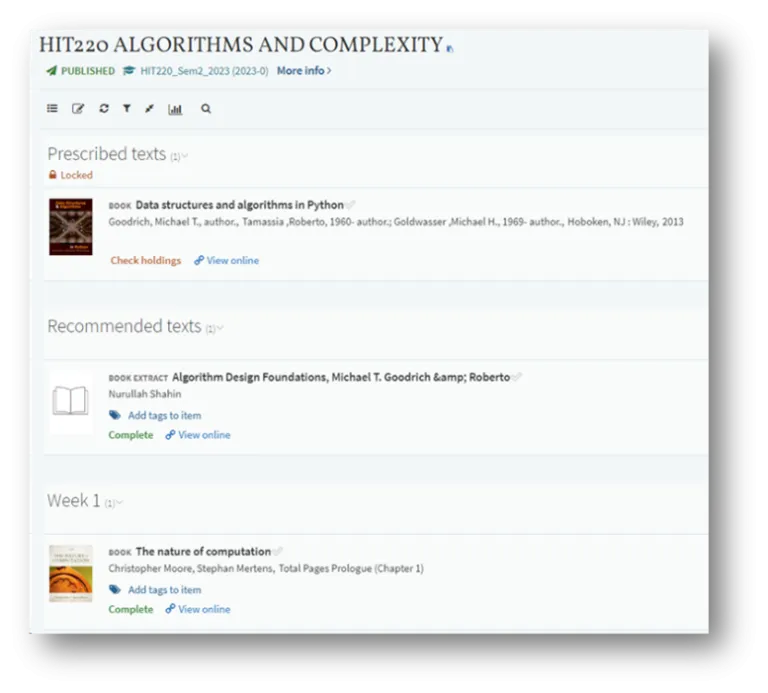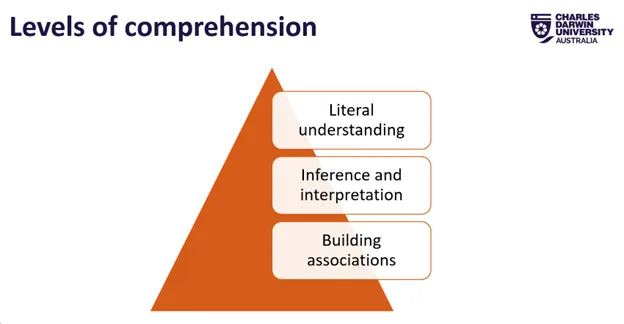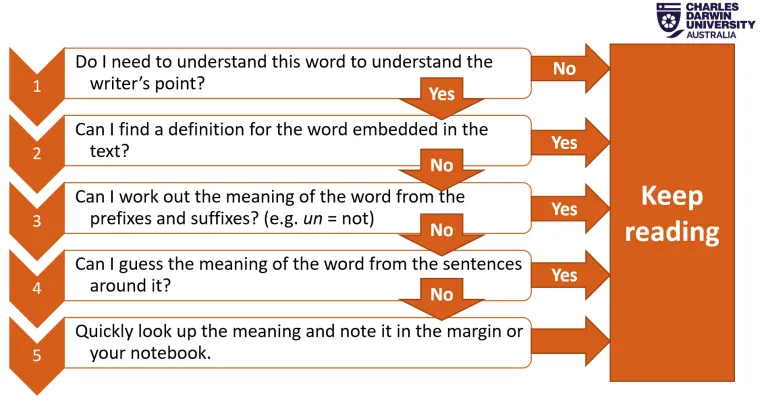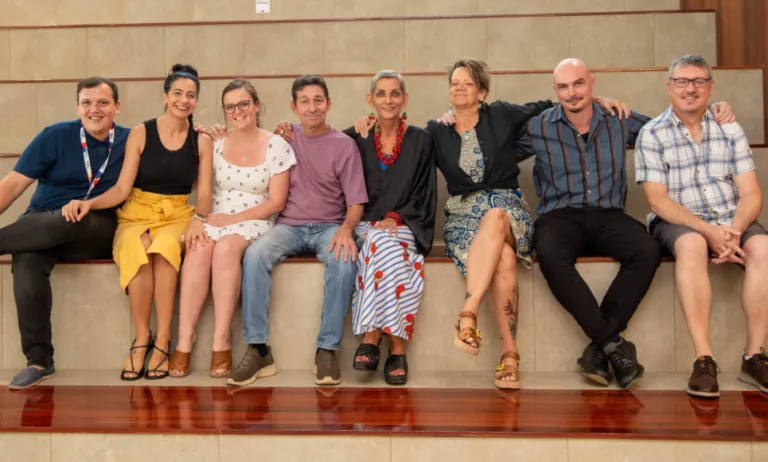Unlike many schools, universities expect students to be autonomous learners. That means you must take responsibility for much of your learning. One way you do this is by reading outside of class. Some new students feel unsure how best to manage their reading. Therefore, this page aims to help you to:
- use a range of skills and strategies to maximise your reading efficiency
- read with purpose
- read critically
- manage your reading challenges.
Download this summary for your reference.
Introduction
This section introduces you to reading at university and gives you a chance to evaluate your own skills.
Self-evaluation
Reflect on your earlier reading experiences. How would you rate your ability in the following knowledge and skills? Rate your ability from ‘good’ to ‘needs development’.
Reflect on your answers. Congratulations if you feel confident about your skills. You may find it helpful to review the materials on this page to confirm your knowledge and possibly learn more. Don't worry if you don't feel confident. Work through these materials to build your skills.
This material is quite long. You may like to schedule two hours to sit down and work through it from start to finish or you may prefer to focus on the topics most relevant to you.
An overview of active reading strategies
Watch the video below to learn about 4 active reading strategies that you can use the next time you're reading some of your course materials.
Reading at university
This section reviews why you read and what type of texts you read at university.
The purpose of reading at university
In your previous education, you may have mostly learned your subject from your teacher, and you may have had one textbook per subject to read. University is different. Why?
| At university, you are expected to learn more independently. You are recommended to spend approximately 10-12 hours per week on each unit. However, you may only have 3 or 4 hours of class. Therefore, your lecturer expects that you will spend the rest of the time reading, researching and doing assignments outside of class. |
| Textbook readings are useful because they give you a solid foundation for your studies. They cover the most important concepts in your discipline. However, they may not explore some advanced or specific topics in-depth, and they can’t tell you about more recent developments. Therefore, you are expected to develop advanced knowledge by exploring journal articles and other sources. |
In short, you will read at university to:
- build your foundational knowledge of your discipline
- prepare for classes
- research information for assignments
- explore topics in more depth.
Readings
At the beginning of each semester, you should start by locating the readings for your units.
In the Student Portal, you can find the reading list icon, which will take you to a site with the readings for each of your units.
Also, in many units in Learnline, you may find:
- unit information with a schedule that may include weekly topics, learning activities and readings
- a link to a reading list with prescribed and additional readings for each week.
In your reading list, you may find:
- Prescribed text(s): this is usually a set textbook for the unit
- Recommended text(s): these are usually texts that supplement the class materials or extend the content in the prescribed text
- Weekly texts: these may be chapters, articles, webpages, or reports that explore specific elements of the weekly topic in more depth.
Make sure that you explore your set readings every week. If your lecturer doesn’t mention the readings in class, it doesn’t mean that you don’t have to do them. In fact, your lecturer MAY NOT:
- remind you to do your weekly readings,
- check that you have done them, or
- discuss them with you in class.
However, your lecturer WILL:
- expect that you have done the reading,
- assume, therefore, that you know the basics of the topic, and
- plan their classes accordingly.
You will find your classes more beneficial and easier to follow if you can do the weekly readings beforehand.
Text types at university
At university, you will read a range of different text types. These may include:
Your reading will be more efficient if you remember two points.
1. You need to know the common text types on your reading list and how these text types are organised.
The type of texts you read at university is influenced by your discipline. For instance, Business students may read more annual reports, while Psychology students may read more diagnostic manuals, such as the DSM.
2. You need to recognise the specific features of texts in your discipline.
Text types are distinguished by the features they share. For instance, almost all research reports begin with an abstract. However, these features might vary in different disciplines. For instance, a Nursing abstract may have headings while a Sociology abstract does not.
Don't worry if this seems confusing. Your knowledge will develop over time. You can also learn more about this in Academic Style – exploring disciplinary differences.
Over to you
Explore the readings in each of your units and consider these questions:
- How many texts do you need to read each week?
- What type of texts seem most common?
Reading sub-skills
This section reviews reading sub-skills, or the different ways you may read different types of text.
Introduction
To manage your reading at university, you need to use different strategies and sub-skills. A strategy is the way you manage your reading, and a sub-skill is the way you read a text.
This activity will guide you through a reflection on how you currently read.
In your daily life, you already use a wide range of different reading strategies and skills, and you probably use these strategies and sub-skills in all the languages you read. Reading for university is the same. You do not need to read every word of every text on your reading lists. In fact, you can't: students are too busy. As a student you must read strategically, using a range of sub-skills.
The next sections revise some of these sub-skills.
Skimming
We skim texts when we read very quickly to get a general overview of the main ideas.
Why do we do this? Consider the list you wrote in the introduction to this section. What items in the list did you skim read?
You may have skimmed:
- your classmates’ discussion board posts to find one that interests you to respond to
- some newspaper stories to stay informed, despite being busy with family in the mornings
- some research articles to decide if they are relevant for an assignment
- a university email in case it has information you need to act on.
Tip: don't read all the text
When you skim a long text, such as a research article, you may get an overview by quickly reading:
- titles, headings and sub-headings
- the abstract
- images and diagrams
- introductions and conclusions
- paragraph topic sentences.
Tip: notice key words
When you skim paragraphs or long passages of text, your eyes should move quickly across the text, but you should only pay attention to the key words.
Practice your skimming by completing the following activity.
You may be surprised to learn that you can get a good sense of the main messages of a text by skimming. However, to grasp the details, you will need to use other reading skills.
Scanning
We scan texts when we read very quickly to search for specific information.
Think about why we do this. Consider the list you wrote in the introduction to this section. What items on the list did you scan?
You may have scanned:
- the bus timetable to find out what time you need to be at the stop to go home
- the cinema program to find out what is showing this Saturday
- library search results to find articles by a scholar recommended by your lecturer
- the contents page of your textbook to find the chapter you need to read this week.
Tip: consider text organisation
When you scan, you use your knowledge of how the text is organised to find what you want. For instance, you don't read everything on a bus timetable. Knowing timetables may be organised by destination and departure time, you would probably:
1) scan the board or map for your destination
2) scan down the list of times till you find what you need.
Tip: predict answers
When scanning, you can find the information you need more quickly if you predict what you might find. For instance, imagine you want to read a text to learn whether the number of lawyers practising in Australia has increased and where the majority practise. You can predict that the answers may include:
- numbers or percentages
- places, such as Australian states and cities
- key words, such as practising lawyers, increase, total, trend, number
Knowing this, you can scan the text more quickly, disregarding irrelevant information.
Practice your scanning by completing the following activity:
Scanning is very useful when you need to find specific details quickly. However, if you want a deeper understanding, you will need to go back and reread the text using different strategies.
Intensive reading
Intensive reading is detailed and focused. You read intensively when you need a good understanding of a text and want to remember what you have learned. We may intensively read complete texts such as complicated instructions from start to finish. However, we usually only intensively read selected sections of longer texts after we have identified what is relevant to our needs.
Think about the list you wrote in the introduction to this section. What did you read intensively?
You may intensively read:
- assignment instructions to ensure you understand exactly what you need to do
- specific, useful sections of research articles or textbook chapters after skimming or scanning
- class notes and lecture slides covering test material.
In these situations, you need to be certain that you have a solid understanding of the content.
Tip: be prepared
If you need to spend some time focusing on intensive reading, you could:
- find a quiet place to read where you are less likely to be disturbed
- wear noise cancelling headphones or ear plugs
- have a spreadsheet, document, or notepad handy for making notes and jotting down questions
- ensure you have bookmarked your favourite dictionary
- have a drink and snacks ready.
Tip: read more than once
To ensure you have grasped the content, you should:
- read the whole text once, noting difficult words or sections, but not stopping
- read the text again, pausing to pay specific attention to more challenging sections and ideas.
Practice reading intensively by completing the following activity:
To select the best answers in this task, you needed to carefully read the text for a good understanding of the content before and after each gap.
Reading with purpose
This section will provide an overview of how you can use different sub-skills and strategies depending on your purpose for reading.
Introduction
As a student reader, you must remember two points.
- Students juggle many different deadlines and commitments. Therefore, you need to use your reading time efficiently.
- Reading is not a passive activity in which you absorb knowledge as your eyes pass over the text. Reading is active. You must work with the text and question it like you are having a conversation with the writer.
You will learn more about active reading in this section and in Critical Reading. To begin with, you can maximise the benefits of your reading by following these tips.
The ability to predict the content of a text and which sections will be most useful for your needs is vital. The next task gives you prediction practice.
The next sections will focus on how you can use different reading strategies depending on your purpose in reading.
Purpose 1: Reading to prepare for class
To read effectively to prepare for class, you need to consider your lecturer's expectations.
Think: What do you think your lecturers expect from you in class? How can you read to prepare for this?
Your lecturers and tutors may expect you to:
- come to class familiar with the basic concepts in the weekly reading
- make connections between the major ideas in your readings and other ideas raised in classes
- ask questions and raise any issues you need to clarify
- be ready to participate in tasks, share your opinions, and discuss issues with peers.
Your lecturers and tutors do NOT expect you to:
- memorise texts or have perfect recall of every text on your reading list
- believe everything you read
- be correct every time you answer a question or offer an opinion in class.
So, how can you be ready for this?
First, use the sub-skills previously explained on this page to read efficiently. Second, consider these tips.
Purpose 2: Reading to write assignments
When you read to gather information to write your assignments, you will use all the skills outlined on this page. However, you will also be searching for and noting information to help you meet task requirements. To do this efficiently, you should:
| 1 | Intensively read the task instructions and analyse the question or writing prompt. Learn more about this in Preparing for the essay. |
| 2 | Refresh your memory on the topic by reviewing your: a. notes from textbook chapters or weekly readings relevant to the topic b. lecture slides and unit information. |
| 3 | Create a plan to answer the question or address the prompt. You can do this by writing some potential headings. Remember, your headings are a draft at this point, and you will probably change or refine them as you learn more about the topic. |
| 4 | Under each heading, make notes outlining what you know about the topic now. This will help you to identify what you need to learn. |
| 5 | Write questions or key words to guide your library research to find useful sources. You can get research advice from the CDU library subject guides or make an appointment with a librarian. |
| 6 | Locate your potential sources, but do NOT read them word for word. Use your time efficiently by surveying the texts, and then skimming and scanning to identify relevant information. |
| 7 | Read the relevant information in your sources intensively and take notes. |
The next section will demonstrate a process for reading and note-taking.
Purpose 3: Reading to make notes
One of the most important things to remember when reading for your assignments is that you should keep careful records and notes. This section outlines a process you can use to take notes from a text.
Imagine you are writing an assignment for a Project Management unit. You need information on the roles of project managers and the types of teams they might manage, and you have found a useful source. Work through this note-taking process.
| 1 | Open a document and write the reference at the top of the page. |
| 2 | Skim the text to get the main idea. |
| 3 | Read again more carefully to identify key words and linkers (language that shows how the ideas are connected, such as therefore, also, both...and). |
| 4 | Note the key words and use symbols and abbreviations to show how the ideas are linked. |
| 5 | Review the notes to check you have expressed the ideas accurately. |
| 6 | Review the notes again a day or so later to check that they still make sense to you. |
This task will take you through the process.
Three tips for creating useful notes for assignment writing
- ALWAYS note the reference details of the source so you have it handy when you need to add citations in your assignments.
- DO NOT copy or cut and paste text into your notes. Use key words, symbols, and abbreviations where possible. This will help you avoid plagiarism later.
- Look for connections between different readings and include these in your notes. This will help you use your sources more effectively when you write your assignment. For example, do different writers:
- agree or disagree on topics
- offer similar or contrasting perspectives
- come to the same or different conclusions about the same evidence?
Using a note-taking matrix will make it easier for you to find connections between your different sources. Look at this example:
You can find more advice on note-taking in the Study Skills pages Literature Review Assignments Organising your notes and Summarising, generalising, paraphrasing and quoting Synthesising sources.
Here is a matrix that you can download and adapt:
Purpose 4: Reading to remember
Not all your reading is to prepare for something, like class work or an assignment. Some reading is for knowledge building. Therefore, you may need to ensure that you have thoroughly understood and can remember the content of some key texts and weekly readings.
One strategy is SQ3R.
SQ3R is a structured approach that can help you better understand and retain information from your important readings. It means Survey, Question, Read, Recite, and Review.
Review the slides below to find out more about the SQ3R strategy.
When you are reading to remember, note-taking is vitally important. You can follow the note-taking process outlined in the previous section and organise the notes so that they act as memory prompts.
Two methods may help you: the SQ3R template and Cornell Notes.
Download these templates and adapt them so that they suit you.
Purpose 5: Reading to improve your writing
Reading and writing are closely linked, and many educators believe that students who read regularly become better writers. This is because reading:
- expands your vocabulary
- provides examples of accurate grammar and sentence structure
- demonstrates how writers in your discipline think and organise text
- exposes you to the writing styles and genres of your discipline.
Many of these benefits occur naturally, but you can speed up the process by becoming a text detective. This means that as you read, you should pay attention to how writers express themselves.
You can learn about this in the CDU Study Skills pages:
Critical reading
This section will introduce you to ways you can develop your critical reading skills.
Introduction
Many students feel uncomfortable when they are told that they are expected to read critically. Some feel that because they are ‘only’ students, they cannot criticise published scholars and experts.
How do you feel?
First, it is important for you to understand that critical reading does not necessarily mean criticising your reading texts. Critical reading could involve criticising texts, but it also means actively thinking about and engaging with texts. The advice offered so far on this page includes many examples of simple critical reading, such as:
- being selective in the texts you choose to read
- reading with a clear purpose
- choosing the most appropriate strategy and sub-skill for your purpose
- being able to survey texts and notice language and organisation
- differentiating between relevant and irrelevant information
- noticing similarities and differences between the ideas in different texts on the same topic.
If you are doing these things, you have already begun developing as a critical reader. To develop further, you need to constantly engage with and question the texts you read. You also need to learn to interpret or infer the meaning in texts.
Engaging with text
A good start in developing your critical reading ability is to engage with text, or in other words, read actively. This section presents two simple frameworks to get you started.
1. The Know Whats
This simple framework is a good beginning for students learning to engage with text. It requires you to ask yourself four questions:
| Before reading | After reading |
|
|
2. QUEST analysis
Once you feel confident using the Know What questions, the QUEST framework will help you engage more deeply when you read. The QUEST analysis asks you to think about a text in five ways using these five words to prompt you: questions, unhappy, excited, strengths, themes.
This tasks shows examples of how one student uses the Know What and the QUEST frameworks to read and take notes. Explore these examples to learn more about these two ways to engage with text.
Download these templates to guide your thinking and take notes as you develop your skills:
Critical questioning
When you have established the habit of engaging with the texts you read, you can learn to question them more critically. This may not come naturally to you at first, but it becomes easier over time with practice. Here are some examples:
Selecting sources:
When you are researching and selecting texts to read, you should use the questions in the CRAAP test. The CRAAP test offers a series of questions about currency, relevance, authority, accuracy and purpose to help you choose good quality sources.
Have a look at the Evaluating Sources page on one of our helpful CDU Library subject guides so that you can refer to the CRAAP questions when researching.
Evaluating research articles:
You may be aware that published research reports have been through a peer review process to ensure that the research is rigorous. However, you should still question the research you read. First, not all research journals are high quality, and second, all research has limitations, and you need to recognise and consider those limitations. You can develop your ability to critically read research by asking yourself a series of questions as you read.
Download and print this useful document so you can refer to the questions while you are reading research.
Evaluating arguments:
When you are reading articles that present an argument, you need to think carefully about the credibility of the arguments and question the evidence. A writer’s opinion on an issue is known as their position. The first thing you need to do as a reader is identify the writer’s position and how they justify it. In many texts, the writer will establish their position early. Look in the introduction for a thesis statement or aim, and then examine the arguments used to support that position.
Download and print this useful document so you can refer to the questions while you are reading arguments.
Levels of comprehension
As an engaged and questioning reader, you may comprehend, or understand, the text in different ways.
Consider this sentence:
My office door is open.
How many meanings for this sentence can you think of? Compare your ideas with these:
| Literal understanding | The narrowest level of understanding is literal. That is, we understand the meaning of the words on the page. In this case, the sentence simply means that the door to the office is not closed. |
| Inference and interpretation | The next level of understanding is when we read between the lines. That is, we infer or interpret the writer’s meaning beyond the words on the page. In this case, we might read this sentence in a Teams message from a colleague and infer we are welcome to drop in for a visit. |
| Building associations | The broadest level is when we apply our understanding of other texts, theories, or practices to the words on the page. In this case, we might read this sentence in an email from a new manager. We may associate it with our knowledge of the business practice known as the ‘open door policy’ and understand that it means the manager is advocating for a flexible approach to communication processes in the business |
As a student, you must comprehend the literal meaning of the texts you read but you also need to move beyond that when necessary. You may notice that in the examples above, the context of the text (a Teams message and a work email) influenced our understanding of the meaning. When reading, ask yourself these questions:
- What is the writer saying?
- In what context was this text written?
- How else could I interpret this text?
- What other knowledge do I have that could be connected to these ideas?
This type of thinking will get easier over time as you build your knowledge of your discipline and the theories and practices that underpin it.
This task requires you to read short texts and answer questions that involve different levels of comprehension.
Reflect on the questions you just answered about the two texts. Some required a literal understanding of the texts, but others encouraged you to think more deeply to infer meaning and associate the ideas with your other knowledge. As a university student, you should try to develop the ability to do this with all your readings.
Managing reading challenges
This section offers strategies for managing some of the reading challenges you may face at university.
Managing unknown vocabulary
Research indicates that you need to know more than 95% of the words in a text to fully understand it. That may seem a lot, but it means that you may meet about two unfamiliar words every ten lines (Coxhead, Nation & Sim, 2015).
Stopping to look up every new word will slow your reading down. When you see unfamiliar vocabulary in your texts, ask yourself these questions:
To manage your reading load, you need strategies for dealing with new words in your readings. You can learn more about these strategies in the CDU Study Skills page Building your vocabulary for university – Unknown vocabulary in reading texts.
Managing your reading load
At first, many new students find the amount of reading – or the reading load – hard to manage. You will manage this load better if you apply the reading sub-skills and strategies on this page. In addition, experienced students develop their own methods for maximising their reading efficiency.
Read these problems shared by CDU students. Think about what you would do in this situation. Then flip the card to read the advice offered by other students. Some of the advice may seem contradictory, but that is okay. What works for one person may not work for another. What is important is that you experiment and find out what works for you.
AI tools for reading
While you are at university, you may hear about AI tools designed to help you with your reading by simplifying or summarising texts for you. It is important for you to understand the advantages and disadvantages of these tools before you decide to use any of them.
| Advantages | Disadvantages |
| AI generated summaries and simplified texts can:
Using AI generated summaries and simplified texts can prevent you from:
|
Gen AI tools can be useful and convenient in your academic and professional life; however, they can be detrimental to you if you constantly use them as shortcuts.
Remember, these points:
- If you read an AI generated summary, you still need to evaluate the output and check the original text.
- You must not cut and paste AI generated summaries into your assignments without acknowledgment. That is plagiarism.
Read more in Using AI Tools at university and Academic Integrity.
Applying your learning
Reflect on what you have learned in this material and consider how you can use it in your own work.
Useful strategies
| Form a reading group | Use the discussion board on your Learnline unit to find friends to create a reading group. Meet regularly face-to-face or online to discuss the unit reading texts. You could:
2. ask each group member to read a different text and:
|
| Make sure you have a reading space | Furniture and equipment:
Place:
|
| Keep useful accessible reading notes |
|
Next steps
Reflect on your learning.
| 1 | Revisit the self-analysis quiz at the top of the page. How would you rate your skills now? |
| 2 | Remember that learning is a process and mistakes aren't a bad thing. They are a normal part of learning and can help you to improve. |
If you would like more support, visit the Language and Learning Advisors page.
We value your opinion. Please click on the button to share your feedback on these materials. |
Did you know CDU Language and Learning Advisors offer a range of study support options?
https://www.cdu.edu.au/library/language-and-learning-support

